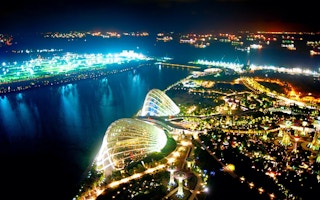Singapore’s Energy Market Authority (EMA) – a statutory board responsible for the nation’s energy supply – has granted conditional licences and conditional approvals to seven Indonesia-based power projects, which would allow the city-state to import a total of 3.4 gigawatts (GW) of low-carbon electricity from the latter.
To continue reading, subscribe to Eco‑Business.
There's something for everyone. We offer a range of subscription plans.
- Access our stories and receive our Insights Weekly newsletter with the free EB Member plan.
- Unlock unlimited access to our content and archive with EB Circle.
- Publish your content with EB Premium.
At the Indonesia International Sustainability Forum in Jakarta last Thursday, the licences and approvals were awarded to the companies who have demonstrated that they had met EMA’s requirements for project feasibility.
A conditional approval is the first of three milestones in the tender process, and is granted if EMA preliminarily assesses that the proposal is both technically and commercially viable. Once the company has further developed its proposal, including obtaining relevant regulatory approvals and securing the necessary finance, EMA may grant a conditional licence.
The last step before a company is authorised to import electricity to Singapore is the attainment of an importer licence, which is provided after the company’s finalised proposal has been deemed to meet EMA’s requirements.
Of the seven companies, five were awarded with conditional licences, and are set to export a total of 2 GW of low-carbon electricity to Singapore from 2028. The other two companies obtained conditional approvals and will account for the remaining 1.4 GW of power.
Currently, the largest to-be importer, which has been granted a conditional approval to provide 1 GW capacity of electricity, is Singa Renewables Pte Ltd – a joint venture between French multinational TotalEnergies and the Singapore-based conglomerate Royal Golden Eagle (RGE).
The other company with a conditional approval is Shell Eastern Trading Pte Ltd, in partnership with renewable energy developer Vena Energy, while the five companies holding conditional licences include Pacific Medco Solar Energy Pte Ltd, Adaro Solar International Pte Ltd, EDP Renewables APAC, Vanda RE Pte Ltd, and Keppel Energy Pte Ltd.

Five companies have been granted conditional licences by Singapore’s Energy Market Authority, while two others have been granted conditional approvals. The seven projects will provide a total of 3.4 GW of import capacity to the city-state. Source: EMA; Image: Eco-Business.
The progress of these seven projects builds on multiple Memoranda of Understanding (MOU) on energy cooperation, signed between Singapore and Indonesia in January 2022, March 2023, and September 2023.
“These MOUs affirm both countries’ commitment to facilitate cross-border trading projects and interconnections between Indonesia and Singapore, and investments in the development of renewable energy manufacturing industries in Indonesia,” EMA said in its press release statement.
The countries’ clean energy ambitions
Both Singapore and Indonesia have included the use of clean energy as a pathway to realise their net-zero emissions targets.
Presently, power generation accounts for 40 per cent of Singapore’s total emissions, but the nation has set out plans to transform its energy supply by tapping on four switches: solar, regional power grids, emerging low-carbon alternatives, and natural gas.
In 2021, Singapore announced that it would import up to 4 GW of low-carbon electricity by 2035, which would account for roughly 30 per cent of the country’s projected electricity supply.
EMA has since revised this target to 6 GW, “given the encouraging progress of electricity import projects, and to ensure adequate supply to meet [the nation’s] energy needs given growing demand”, it said in its most recent statement.
Prior to these new arrangements with Indonesia, Singapore has already been importing renewable hydropower from the Lao People’s Democratic Republic (PDR) since June 2022, under the Lao PDR-Thailand-Malaysia-Singapore Power Integration Project.
Meanwhile, Indonesia has reduced its renewable energy target from an initial 26 per cent to between 19 to 21 per cent by 2030, though the country has also proposed to increase its renewable energy target to 44 per cent by the same year, under the Just Energy Transition Partnership (JETP) investment proposal.
According to latest statistics by the Institute for Energy Economics and Financial Analysis (IEEFA), Indonesia’s share of renewable energy in the electricity mix last year was 13.1 per cent, which falls short of the 17.9 per cent target.
This is despite the country having invested more in renewables than any other country in Asean in 2023.
Numerous obstacles, including subsidies for fossil fuels and the monopolistic energy market structure, have continued to hinder the development of renewables in Indonesia.
Jakarta has previously suspended the export of electricity from new and renewable energy sources to prioritise green power for domestic industries, a move that has raised doubts about the nation’s plans for export-focused renewable energy projects.
When realised, however, these projects are expected to catalyse Indonesia’s green economy by supporting investments for manufacturing solar photovoltaics and battery energy storage systems, said Teo Chee Hean, who is Singapore’s senior minister and coordinating minister for national security, in his keynote speech at the Indonesia Sustainability Forum on 5 September.
Teo added that this regional collaboration will also create new opportunities and pave the way for a more climate resilient and integrated Asean.
As Singapore continues to decarbonise, EMA said it will seek to strike an optimal balance between energy security, sustainability and cost-competitiveness. It will do so by studying all decarbonisation pathways for the power sector, including hydrogen, solar, deep geothermal energy, nuclear energy, and carbon capture and storage technologies.










